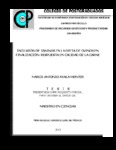| dc.description.abstract | El objetivo fue evaluar el efecto de incluir follaje de Guácimo (Guazuma ulmifolia) como fuente de taninos en la dieta de corderos en la respuesta productiva, y estabilidad del color y características de la carne. El estudio se dividió en dos etapas: la primera consistió en evaluar el comportamiento productivo, y la segunda, en evaluar las características físico-químicas de la carne. Se utilizaron 28 corderos Pelibuey machos, con peso inicial de 23.6 + 1.0 kg (n=7 corderos por tratamiento), asignados al azar a uno de los siguientes tratamientos: 1) Testigo (dieta base), 2) Dieta base con 1.5% taninos (BS), 3) Dieta base con 2.5% taninos (BS), y 4) Dieta base con 1,000 UI de Vit E, y sacrificados a 39 + 0.5 kg PV promedio. En la primera etapa, se evaluó consumo de materia seca, ganancia diaria de peso, conversión y eficiencia alimenticia, grosor de grasa dorsal, rendimiento en canal caliente y fría, rendimiento biológico en canal caliente y fría, pH al sacrificio y a 24 horas postmortem, y digestibilidad in vitro de la materia seca de las dietas. En la segunda etapa, se evaluó la composición química de la carne, color, resistencia al corte en carne cruda y cocida, y actividad del agua (Aw). En ambas etapas, se utilizó un diseño completamente al azar, utilizando el PROC GLM de SAS, y la prueba de Tukey para comparación de medias. No hubo diferencias (P>0.05) entre tratamientos en ninguna de las variables evaluadas, excepto en color de la carne, que en general, presentó mayores (P < 0.05) valores de L (34.88), a (11.49) y b (2.28), para el tratamiento con taninos en la dieta, aunque no varió (P > 0.05) a través de los días. Las dietas con follaje de Guácimo tuvieron menor degradabilidad (P<0.05). Incluir taninos en la dieta de ovinos, podría ser una opción viable, ya que no afectan el consumo de materia seca, y actúan como gentes antioxidantes naturales, al mantener la estabilidad del color de la carne por mayor tiempo. _______________ ABSTRACT: The objective of this study was to evaluate the effect of including Guácimo fodder (Guazuma ulmifolia) as a source of tannins in the of lambs’ diet, of on performance and meat quality. The study was performed in two stages: 1) performance, and 2) meat quality. Twenty-eight male Pelibuey lambs weighting 23.6 + 1.0 kg were examined. Lambs were, randomly assigned to one of the foor treatments (n=7 lambs per treatment): 1) Control (basal diet), 2) basal diet containing 1.5% tannins (BS), 3) basal diet containing 2.5% tannins (BS), and 4) basal diet 1,000 IU of Vitamin E added. The animals were slaughtered at 39 ± 0.5 kg of liveweight. In the first stage, dry matter intake, daily weight gain, feeding and efficiency conversion, backfat thickness, hot and cold carcass yield, biological hot and cold carcass yield, pH at slaughtering and 24 hours postmortem, were evaluated. In vitro digestibility of the diets was also assessed. In the second stage, meat chemical composition, meat color, texture of raw and cooked meat, and water activity (Aw), were evaluated. In both cases, a completely randomized, design was performed using the PROC GLM, and a mean comparison was done using the Tukey test. No differences (P > 0.05) among treatments on animal performance or meat quality variables. Diets containing Guácimo fodder had lower, dry matter degradability (P < 0.05). Meat color differed (P < 0.05) among treatments, with higher values for L (34.88), a (11.49), and b (2.28), when tannins were added to the diet, although it did not change throughout the experimental period. Including Guácimo fodder as a source of tannins in the diet of lambs do not affect dry matter intake, but have an effect as natural antioxidants, enhancing meat color stability for longer periods. | en_US |


